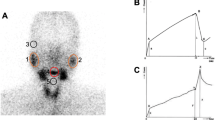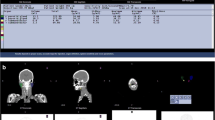Abstract
Salivary gland scintigraphy with technetium-99m pertechnetate was used to follow changes in the excretion and uptake function of the major salivary glands until 1 year after irradiation. Twenty-five patients who received radiotherapy for head and neck tumours were included in the study. Seventy-nine salivary glands (39 parotid and 40 submandibular) were evaluated in relation to the average received radiation dose. Salivary gland scintigraphy was performed before and 1, 6 and 12 months after radiotherapy. For each gland the excretion response to carbachol, evaluated by calculation of the salivary excretion fraction (SEF), the cumulative gland uptake (CGU) and the absolute excreted activity (AEA) at various intervals after radiotherapy were compared with the baseline values. The excretion response decreased in 20 of 25 patients at 1 month after radiotherapy. One month after radiotherapy both SEF and AEA decreased significantly in relation to the radiation dose. These decreases in excretion parameters persisted during the follow-up period. Parotid excretion was affected significantly more than submandibular excretion. CGU values did not change significantly until 6 months after radiotherapy, but at 12 months a significant decrease related to radiation dose was observed. Xerostomia was assessed during radiotherapy and on the days of the scintigraphic tests. The incidence of xerostomia did not correspond to the effects observed in the scintigraphy studies. It is concluded that radiotherapy induces early and persistent impairment of salivary gland excretion, related to the radiation dose. This impairment is stronger in parotid glands than in submandibular glands.
Similar content being viewed by others
References
Tsujii H. Quantitative dose-response analysis of salivary function following radiotherapy using sequential ri-sialography.Int J Radiat Oncol Biol Phys 1985; 11: 1603–1612.
Wiesenfeld D, Webster G, Cameron F, Ferguson MM, MacFadyen EE, MacFarlane TW. Salivary gland dysfunction following radioactive iodine therapy.Oral Surg Oral Med Oral Pathol 1983: 55: 138–141.
Leslie MD, Dische S. The early changes in salivary gland function during and after radiotherapy given for head and neck cancer.Radiother Oncol 1994; 30: 26–32.
Jansma J, Vissink A, Spijkervet FKL, et al. Protocol for the prevention and treatment of oral sequelae resulting from head and neck radiation therapy.Cancer 1992; 70: 2171–2180.
Kohn WG, Ship JA, Atkinson JC, Patton LL, Fox PC. Salivary gland99mTc-scintigraphy: a grading scale and correlation with major salivary gland flow rates.J Oral Pathol Med 1992; 21: 70–74.
Valdés Olmos RA, Keus RB, Takes RP, van Tinteren H, Baris G, Hilgers FJ, Hoefnagel CA, Balm AJ. Scintigraphic assessment of salivary function and excretion response in radiationinduced injury of the major salivary glands.Cancer 1994; 73: 2886–2893.
Watkinson JC. Nuclear medicine in otolaryngology.Clin Otolaryngol 1990; 15: 457–469.
Valdez III, Atkinson JC, Ship JA, Fox PC. Major salivary gland function in patients with radiation-induced xerostomia: flow rates and sialochemistry.Int J Radiat Oncol Biol Phys 1993; 25: 41–47.
Franzen L, Funegard U, Ericson T, Henriksson R. Parotid gland function during and following radiotherapy of malignancies in the head and neck, a consecutive study of salivary flow and patient discomfort.Eur J Cancer 1992, 28: 457–462.
Markitzin A, Zafiropoulos G, Tsalikis L, Cohen L. Gingival health and salivary funtion in head and neck-irradiated patients, a five-year follow-up.Oral Surg Oral Med Oral Pathol 1992; 73: 427–433.
Wolff A, Atkinson JC, Macynski AA, Fox PC. Pretherapy interventions to modify salivary dysfunction.NCI Monogr 1990; 9: 87–90.
Bohuslavizki KH, Brenner W, Wolf H, Sippel C, Tonshoff G, Tinnemeyer S, Clausen M, Henze E. Value of quantitative salivary gland scintigraphy in the early stage of Sjbgren's syndrome.Nucl Med Commun 1995; 16: 917–922.
Bohuslavizki KH, Karde P, Winter M, Sippel S, Tinnemeyer S, Brenner W, Wolf H, Schramm M, Stauch C, Clausen M, Henze E. Standardized uptake and excretion fraction in salivary glands derived from 116 normals [abstract].Eur J Nucl Med 1995; 22: 801.
Stephens LC, Schultheiss TE, Price RE, Ang KK, Peters LJ. Radiation apoptosis of serous acinar cells of salivary and lacrimal glands.Cancer 1991; 67: 1539–1543.
LeVeque FG, Montgomery M, Potter D, Zimmer MB, Rieke JW, Steiger BW, Gallagher SC, Muscoplat CC. A multicenter, randomized, double blind, placebo-controlled, dose-titration study of oral pilocarpine for treatment of radiation-induced xerostomia in head and neck cancer.J Clin Oncol 1993; 11: 1124–1131.
Milne RW Dawes C. The relative contributions of different salivary glands to the blood group activity of whole saliva in humans.Vox Sang 1973; 25: 298–307.
Rieke JW, Hafermann MD, Johnson JT, LeVeque FG, Iwamoto R, Steiger BW, Muscoplat C, Gallagher SC. Oral pilocarpine for radiation-induced xerostomia: integrated efficacy and safety results from two prospective randomized clinical trials.Int J Radiat Oncol Biol Phys 1995; 31: 661–669.
Johnson JT, Ferretti GA, Nethery WJ, Valdez III, Fox PC, Ng D, Muscoplat CC, Gallagher SC. Oral pilocarpine for post-irradiation xerostomia in patients with head and neck cancer.N Engl J Med 1993; 329: 390–395.
Valdez IH, Wolff A, Atkinson JC, Macynski AA, Fox PC. Use of pilocarpine during head and neck radiation therapy to reduce xerostomia and salivary dysfunction.Cancer 1993; 71: 1848–1851.
Author information
Authors and Affiliations
Rights and permissions
About this article
Cite this article
Liem, I.H., Valdés Olmos, R.A., Balm, A.J.M. et al. Evidence for early and persistent impairment of salivary gland excretion after irradiation of head and neck tumours. Eur J Nucl Med 23, 1485–1490 (1996). https://doi.org/10.1007/BF01254473
Received:
Revised:
Issue Date:
DOI: https://doi.org/10.1007/BF01254473




